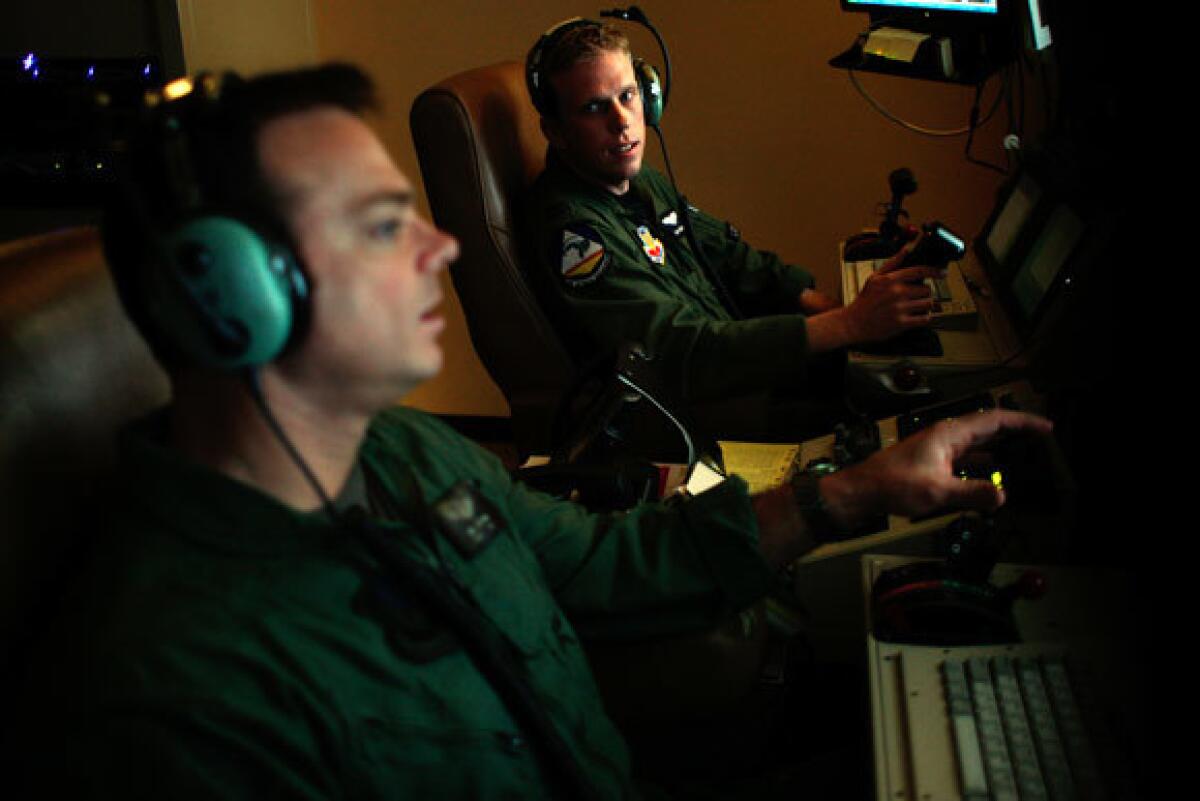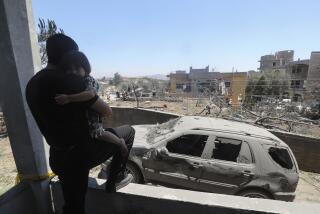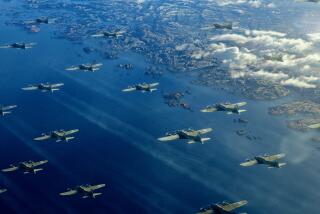Drone pilots have a front-row seat on war, from half a world away

Reporting from Creech Air Force Base, Nev. -- From his apartment in Las Vegas, Sam Nelson drove to work through the desert along wind-whipped Highway 95 toward Indian Springs. Along the way, he tuned in to XM radio and tried to put aside the distractions of daily life -- bills, rent, laundry -- and get ready for work.
Nelson, an Air Force captain, was heading for his day shift on a new kind of job, one that could require him to kill another human being 7,500 miles away.
Seated in a padded chair inside a low, tan building, he controlled a heavily armed drone aircraft soaring over Afghanistan. When his shift ended, he drove 40 minutes back through the desert to the hustle and neon of Las Vegas.
Drone pilots and crews are the vanguard of a revolution in warfare, one that the U.S. military and intelligence agencies have bet on heavily. The first Predator carrying weapons was rushed to Afghanistan just four days after the Sept. 11, 2001, terrorist attacks. Today, the Air Force is spending nearly $3 billion a year buying and operating drones, and is training pilots to fly more unmanned than manned aircraft. Demand is so strong that even non-pilots such as civil engineers and military police are being trained.
More than 7,000 drones of all types are in use over Iraq and Afghanistan. The planes have played an integral part in the offensive now being carried out in Marja, Afghanistan, by U.S. Marines and British and Afghan troops.
The Pentagon has adapted consumer-driven technology such as satellite television and digital video to give pilots, combat troops and commanders at headquarters a real-time look at the enemy on computer screens. For the first time in warfare, troops on the ground can see the enemy miles away on live video feeds.
Drone strikes in Pakistan are part of a separate CIA program that has killed more than two dozen senior Al Qaeda and Taliban figures, including two leaders of the Pakistani Taliban in the last six months.
But the attacks also kill civilians, inflaming the sentiment that the United States is fighting an undeclared, illegal war from the skies over that country. Some critics say the problems are so serious that the entire program is counterproductive and should be shut down.
This is combat in the age of video games and virtual reality. Even though drone pilots operate from half a world away, they are as engaged in deadly combat as any pilot inside an airplane.
A drone pilot can fire on an insurgent dug into the Afghan hills and be home in time for a backyard barbecue. In just an hour or two, the pilot can go from a heated argument with a spouse to a tense radio conversation with an amped-up soldier pinned down by weapons fire.
“On the drive out here, you get yourself ready to enter the compartment of your life that is flying combat,” said retired Col. Chris Chambliss, who until last summer commanded drone operations at Creech Air Force Base, the command center for seven Air Force bases in the continental U.S. where crews fly drones over Iraq and Afghanistan. “And on the drive home, you get ready for that part of your life that’s going to be the soccer game.”
Drone crews don’t put their lives at risk. Instead, they juggle vast streams of video and data. With briefings both before and after their missions, their workdays typically stretch to 10 or 11 hours. Many of the pilots are experienced military fliers, but the camera operators tend to be much younger -- often only 19 or 20, and new to the stresses of combat.
Just like troops in Iraq or Afghanistan, drone crews have access to chaplains, psychologists and doctors. They are taught to keep an eye on one another for signs of stress.
The psychological challenges are unique: Pilots say that despite the distance, the video feed gives them a more intimate feel for the ground than they would have from a speeding warplane. Some say they would prefer to be in Afghanistan or Iraq to avoid the daily adjustment from the soccer field to the battlefield.
After his stint in Nevada flying drones, which the military refers to as “remotely piloted aircraft,” Nelson recently transferred to a crew at an air base in Kandahar, Afghanistan.
Crews there and in Iraq, often battling high winds and freezing temperatures, control the drones on takeoff and landing, then hand them off to the U.S.-based teams.
While still in Nevada, after arriving for his shift on a mild day bathed in brilliant sunshine, Nelson received a battlefield briefing and then opened the door to his office -- the ground control station. He settled into the cockpit seat, known to pilots as the “Naugahyde Barcalounger,” facing computer screens displaying live images from the mountains of Afghanistan -- color during the day, black-and-white at night.
As in any other cockpit, he had readouts for engine speed and temperature, altitude, fuel, pitch and roll angles, as well as other flight data.
At his fingertips were two keyboards. He could type messages in chat rooms connecting him to scores of military personnel and analysts worldwide, and he could call up maps, satellite images and intelligence reports. He talked by radio with ground commanders and troops who saw the same live images on their laptops and hand-held radios.
Inside the climate-controlled ground station, Nelson, a slender 30-year-old, spent the next six hours amid the hum of computer servers and the occasional click of keyboards.
Early in the shift, a roadside bomb exploded in the Afghan night. Using a throttle and joystick, Nelson maneuvered a 36-foot-long Reaper drone armed with Hellfire missiles and 500-pound bombs to a mountain valley in eastern Afghanistan, where a plume of black smoke rose over the site.
A convoy of Humvees had stopped a safe distance away, the vehicles a ribbon of boxy shapes on the screen as the Reaper soared several thousand feet overhead.
For the next hour, Nelson watched until the vehicles crept past the bomb site and safely reached their base. Then he flew on to his next assignment, watching another convoy miles away.
Next to Nelson, who flew C-5 cargo planes in Iraq before volunteering to pilot drones, was Tech. Sgt. Jim Jochum, who operated the cameras. An intelligence coordinator, whose job is to study the imagery, was posted next door.
Locked in on a mission, they often forget they’re in Nevada. Capt. Mark Ferstl, a former B-52 pilot, said drone pilots typically feel more intimately involved in combat than they did when they sat in actual cockpits.
“When I flew the B-52, it was at 30,000 to 40,000 feet, and you don’t even see the bombs falling,” Ferstl said. “Here, you’re a lot closer to the actual fight, or that’s the way it seems.”
Nelson recalled one instance when he received an urgent radio call from a ground controller whose unit was under fire.
“You could tell he was running, and you could hear shots being fired at the enemy,” Nelson said. He tracked the insurgents and targeted them for two F-16 fighter planes that attacked and killed them, he said.
“Just hearing the voice of the [controller] running, excited, tension in his voice, just asking for any air support, anywhere, hearing the gunfire, it felt good to be able to help him out,” Nelson said.
As Predator drones and the larger and more powerful Reapers became prevalent in the Afghan and Iraq wars, the Air Force took pilots away from manned aircraft to fly them. Many were reluctant to switch.
“From a personal reward standpoint, it’s way more fun to climb up the ladder, throw the white scarf around your neck, and get into an F-16 cockpit,” said Chambliss, a former fighter pilot who volunteered to fly drones. “But from a combat effectiveness standpoint, it’s not even close.
“You can look at guys walking down a road and tell whether any of them are armed,” he said. “You can zoom in from an ultra-wide to a road intersection” to look for bombs.
Though more than 95% of their missions involve gathering intelligence or watching over troops, pilots sometimes must decide whether to open fire. They operate under the same rules as pilots of fighter jets or attack helicopters. Only after going through a long checklist of safeguards are they cleared to push a black button on the throttle and squeeze a gray trigger on the joystick to release a bomb or missile.
The pilots call out “Three, two, one, rifle!” as the weapon launches and “Splash!” when it hits its target.
The job also involves confirming deaths, by drone or manned aircraft. Then crew members focus on corpses and ruined buildings.
“You see a lot of detail,” Chambliss said. “We feel it, maybe not to the same degree as if we were actually there, but it affects us. Part of the job is to try to identify body parts.”
A 50-year-old senior master sergeant and camera operator said veteran personnel keep an eye on young crew members for signs of stress.
“They’re continually reminded that they’re not just sitting outside Las Vegas doing a job,” said the sergeant, who for security reasons identified himself only by his first name, Ralph. “I talk to these youngsters quite often, especially after they’ve seen their first shot, to make sure they don’t keep things bottled up and are able to decompress.”
Col. Dale Fridley, a 50-year-old former F-15 pilot, said one of his most rewarding moments as a drone pilot came without firing a shot.
After a U.S. military vehicle broke down in the desert in Afghanistan’s Helmand province, a Taliban stronghold, the rest of the convoy returned to base.
The stranded soldiers were able to sleep while Fridley’s drone stood watch overhead, awaiting a repair crew’s arrival in the morning.
“And that,” Fridley said, “was something that was never, ever possible before.”
david.zucchino @latimes.com
First in a series of occasional articles about America’s remote-controlled warfare.
More to Read
Sign up for Essential California
The most important California stories and recommendations in your inbox every morning.
You may occasionally receive promotional content from the Los Angeles Times.











